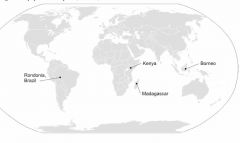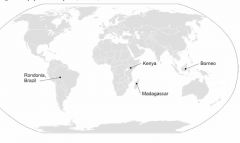![]()
![]()
![]()
Use LEFT and RIGHT arrow keys to navigate between flashcards;
Use UP and DOWN arrow keys to flip the card;
H to show hint;
A reads text to speech;
35 Cards in this Set
- Front
- Back
|
1. For each of the ten categories of land use by humans, list: 1) The nature of the activity 2) An example of the activity 3) The reasons why humans are using the land in this way. (doesn't on the test) |
Farming, Agriculture... Crops and their domesticated animals. To grow their own food. Homes, settlements, markets and trade centers... cities, trade, broker. To persist and expand in certain pockets in which the farm land was productive. Transportation... Streets, railroads and stations, seaports, airports. To flourish and spread cities' economy. Timber and wood harvesting. Deforestation Mining and fossil fuel extraction – minerals, oil patches, coal mines Energy farms – wind farms solar farms Industrial production Water and energy distribution – dams, reservoirs, aqueducts, pipelines, power lines Solid waste generation – landfills Military – bases, training, war, bombs, troop movements, defoliants Expansive human population |
|
|
2. Considering solid waste production. On average, Americans produce about 4-1/2 pounds of solid waste (trash) per day. How many pounds of trash do Americans produce per year? |
1642.5 pounds (times 365) |
|
|
3. Why do countries have militaries?
|
To secure the country’s way of life, in particular, the normal operations of the country’s economic system. |
|
|
4. What was the world human population in the 1300s?
|
Only about 350 million |
|
|
5. What is the current world human population? |
Over 7 billion |
|
|
6. Calculate the proportional increase in humans. Population today divided by the population in the 1300s. (not on the test) |
20 |
|
|
7. As human population increases, what does that do to the demand for land? What does that do to the amount of undisturbed space? |
Demand for land increase and more of the planet’s surface must be transformed to support specifically human kinds of activities. There will be less and less undisturbed space for the non-human inhabitants of Earth. |
|
|
8. Be able to locate Madagascar on a world map. |

|
|
|
9. What were the main causes for habitat loss on Madagascar?(3)
|
Large scale deforestation Timber harvesting Cattle grazing. |
|
|
10. How did humans manage the land on Madagascar after they cleared the forests? What was the result?
|
The remaining land was poorly managed such that the bulk of the island now suffers from severe topsoil erosion. |
|
|
11. What is an endemic species?
|
A species that exists in one geographic location and nowhere else. |
|
|
12. What percentage of species on Madagascar are endemic? Give examples.
|
90% |
|
|
13. Be able to locate Borneo on a world map. |

|
|
|
14. How did humans manage the land on Borneo after they cleared the forest? What was the result? |
Much of the deforested land has been converted to plantations, especially palm oil plantations. As a result, the expanding loss and fragmentation of habitat for the indigenous species of Borneo. |
|
|
15. Give examples of endemic and rare species that live on Borneo.
|
Bornean Orangutan Red-haired great ape Many forest-dwelling tropical birds Nearly 100 species of bats Borneo elephant |
|
|
16. Be able to locate Kenya on a world map. |
|
|
|
17. How did humans manage the land in Kenya after they cleared the savannah? What was the result? |
Kenyans have made significant attempts to prevent soil erosion, and restore deforested land to productivity. To reduce erosion, there is extensive use of terraced slopes. |
|
|
18. Give examples of endangered and vulnerable species that live in Kenya. |
African wild dog Cheetah |
|
|
19. Be able to locate Rondonia, Brazil on a world map. |
P6 |
|
|
20. What is most remarkable about the deforestation in Rondonia. |
In the early 1970s, the Brazilian government built a road deep into the Rondonia frontier and invited Brazilians to settle there. What is most striking is the speedy transformation of the district. This was an aggressive, well-planned, industrial scale and extremely efficient deforestation project. The precise geometric branching pattern of the regions roads expresses this exquisitely. |
|
|
21. How did humans manage the land in Rondonia after they cleared the tropical rain forest? What was the result?
|
Rather than farm the land, most settlers became ranchers and now run small herds of cattle. Today, satellite images show that the overwhelming majority of cleared land in Rondonia is dedicated to cattle grazing. |
|
|
22. Give examples of species in decline in Rondonia. |
Rondon’s marmoset
Rondonia bushbird Jaguar Howler Monkey Ocelot Scarlet Macaw Harpy eagle |
|
|
23. What percentage of wilderness remains in Europe and America? |
1% to 3% |
|
|
24. Be able to locate southern California on a world map. |
a |
|
|
25. How did humans manage the land in southern California after they cleared the chaparral? What was the result? |
European settlers claimed ownership of the land and set fire to it, clearing away the shrubbery to make room for their crops and cattle.
Remnants of those natural habitats survive in hilly, hard-to-develop terrain such as the Santa Monica Mountains, Hollywood Hills, and Santa Ana Mountains. |
|
|
26. Give examples of species in decline in southern California. |
California gnatcatcher (endangered) Mountain Lion Bobcat. |
|
|
27. What is habitat fragmentation and why is it bad?
|
Instead of existing as one large contiguous block of habitat, the habitat has become subdivided into smaller fragments. Fragmentation is bad for natural populations because as the habitat is reduced, natural populations decline, due to reduced availability of space and resources. |
|
|
28. What is the “edge effect”? Give examples of edge effects.
|
The disturbance that the overall impact to the natural habitat is greater than one acre that humans develop because the activities occurring in that acre also disturb the nearby surroundings. |
|
|
29. What are the five characteristics that make some species particularly vulnerable to human influences? |
1) Species whose populations are critically small 2) Species that have very specialized habitats 3) Migratory species 4) Species that are a threat to human commercial operations 5) Species that yield big money |
|
|
30. Give examples of species from each category. |
1) Small populations... California condor, Arabian Oryx 2) specialized habitats... Light-Footed Clapper rail, California gnatcatcher 3) Migratory... Wildebeest and zebra, salmon 4) Cheetahs, Jaguars, grizzly bears and wolves 5) Whooping Crane, elephants, Black and White Rhinos, Any cat with spotted fur, Gorillas, Beavers |
|
|
31. How are conservation biologists attempting to save the California condor and the Arabian oryx? |
captive breeding program |
|
|
32. What are the specialized habitats of the light footed clapper rail and the California gnatcatcher? |
Light footed clapper... Coastal salt marsh habitat California Gnatcather... Coastal sage scrub habitat |
|
|
33. In Kenya, why is migration getting more troublesome for wildebeests? |
1) Their historical routes are blocked (including blocked access to strategic water holes) 2) There is less food available for them. |
|
|
34. In Oregon, why has migration become more difficult for salmon? What are the problems with dams, reservoirs and warmer river water? |
1) Dams block salmon migration up and down the river. 2) The warm waters in dam’s reservoirs can support more salmon predators, and make salmon more vulnerable to disease. |
|
|
35. Why are cheetahs attacking livestock introduced by farmers in Africa? How do the farmers react?
|
Faced with hunger and dwindling wild prey, cheetahs hunt domesticated livestock. Farmers and cattlemen respond by shooting cheetahs. |

